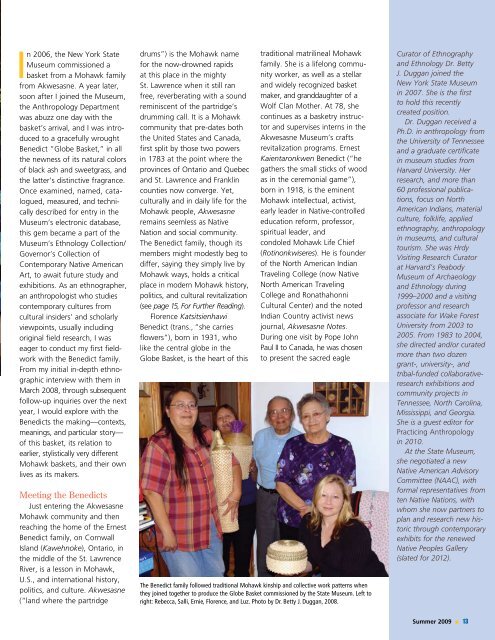Distinctly Dutch - New York State Museum
Distinctly Dutch - New York State Museum
Distinctly Dutch - New York State Museum
Create successful ePaper yourself
Turn your PDF publications into a flip-book with our unique Google optimized e-Paper software.
In 2006, the <strong>New</strong> <strong>York</strong> <strong>State</strong><br />
<strong>Museum</strong> commissioned a<br />
basket from a Mohawk family<br />
from Akwesasne. A year later,<br />
soon after I joined the <strong>Museum</strong>,<br />
the Anthropology Department<br />
was abuzz one day with the<br />
basket’s arrival, and I was introduced<br />
to a gracefully wrought<br />
Benedict “Globe Basket,” in all<br />
the newness of its natural colors<br />
of black ash and sweetgrass, and<br />
the latter’s distinctive fragrance.<br />
Once examined, named, catalogued,<br />
measured, and technically<br />
described for entry in the<br />
<strong>Museum</strong>’s electronic database,<br />
this gem became a part of the<br />
<strong>Museum</strong>’s Ethnology Collection/<br />
Governor’s Collection of<br />
Contemporary Native American<br />
Art, to await future study and<br />
exhibitions. As an ethnographer,<br />
an anthropologist who studies<br />
contemporary cultures from<br />
cultural insiders’ and scholarly<br />
viewpoints, usually including<br />
original field research, I was<br />
eager to conduct my first fieldwork<br />
with the Benedict family.<br />
From my initial in-depth ethnographic<br />
interview with them in<br />
March 2008, through subsequent<br />
follow-up inquiries over the next<br />
year, I would explore with the<br />
Benedicts the making—contexts,<br />
meanings, and particular story—<br />
of this basket, its relation to<br />
earlier, stylistically very different<br />
Mohawk baskets, and their own<br />
lives as its makers.<br />
Meeting the Benedicts<br />
Just entering the Akwesasne<br />
Mohawk community and then<br />
reaching the home of the Ernest<br />
Benedict family, on Cornwall<br />
Island (Kawehnoke), Ontario, in<br />
the middle of the St. Lawrence<br />
River, is a lesson in Mohawk,<br />
U.S., and international history,<br />
politics, and culture. Akwesasne<br />
(“land where the partridge<br />
drums”) is the Mohawk name<br />
for the now-drowned rapids<br />
at this place in the mighty<br />
St. Lawrence when it still ran<br />
free, reverberating with a sound<br />
reminiscent of the partridge’s<br />
drumming call. It is a Mohawk<br />
community that pre-dates both<br />
the United <strong>State</strong>s and Canada,<br />
first split by those two powers<br />
in 1783 at the point where the<br />
provinces of Ontario and Quebec<br />
and St. Lawrence and Franklin<br />
counties now converge. Yet,<br />
culturally and in daily life for the<br />
Mohawk people, Akwesasne<br />
remains seemless as Native<br />
Nation and social community.<br />
The Benedict family, though its<br />
members might modestly beg to<br />
differ, saying they simply live by<br />
Mohawk ways, holds a critical<br />
place in modern Mohawk history,<br />
politics, and cultural revitalization<br />
(see page 15, For Further Reading).<br />
Florence Katsitsienhawi<br />
Benedict (trans., “she carries<br />
flowers”), born in 1931, who<br />
like the central globe in the<br />
Globe Basket, is the heart of this<br />
traditional matrilineal Mohawk<br />
family. She is a lifelong community<br />
worker, as well as a stellar<br />
and widely recognized basket<br />
maker, and granddaughter of a<br />
Wolf Clan Mother. At 78, she<br />
continues as a basketry instructor<br />
and supervises interns in the<br />
Akwesasne <strong>Museum</strong>’s crafts<br />
revitalization programs. Ernest<br />
Kaientaronkwen Benedict (“he<br />
gathers the small sticks of wood<br />
as in the ceremonial game”),<br />
born in 1918, is the eminent<br />
Mohawk intellectual, activist,<br />
early leader in Native-controlled<br />
education reform, professor,<br />
spiritual leader, and<br />
condoled Mohawk Life Chief<br />
(Rotinonkwiseres). He is founder<br />
of the North American Indian<br />
Traveling College (now Native<br />
North American Traveling<br />
College and Ronathahonni<br />
Cultural Center) and the noted<br />
Indian Country activist news<br />
journal, Akwesasne Notes.<br />
During one visit by Pope John<br />
Paul II to Canada, he was chosen<br />
to present the sacred eagle<br />
The Benedict family followed traditional Mohawk kinship and collective work patterns when<br />
they joined together to produce the Globe Basket commissioned by the <strong>State</strong> <strong>Museum</strong>. Left to<br />
right: Rebecca, Salli, Ernie, Florence, and Luz. Photo by Dr. Betty J. Duggan, 2008.<br />
Curator of Ethnography<br />
and Ethnology Dr. Betty<br />
J. Duggan joined the<br />
<strong>New</strong> <strong>York</strong> <strong>State</strong> <strong>Museum</strong><br />
in 2007. She is the first<br />
to hold this recently<br />
created position.<br />
Dr. Duggan received a<br />
Ph.D. in anthropology from<br />
the University of Tennessee<br />
and a graduate certificate<br />
in museum studies from<br />
Harvard University. Her<br />
research, and more than<br />
60 professional publications,<br />
focus on North<br />
American Indians, material<br />
culture, folklife, applied<br />
ethnography, anthropology<br />
in museums, and cultural<br />
tourism. She was Hrdy<br />
Visiting Research Curator<br />
at Harvard’s Peabody<br />
<strong>Museum</strong> of Archaeology<br />
and Ethnology during<br />
1999–2000 and a visiting<br />
professor and research<br />
associate for Wake Forest<br />
University from 2003 to<br />
2005. From 1983 to 2004,<br />
she directed and/or curated<br />
more than two dozen<br />
grant-, university-, and<br />
tribal-funded collaborativeresearch<br />
exhibitions and<br />
community projects in<br />
Tennessee, North Carolina,<br />
Mississippi, and Georgia.<br />
She is a guest editor for<br />
Practicing Anthropology<br />
in 2010.<br />
At the <strong>State</strong> <strong>Museum</strong>,<br />
she negotiated a new<br />
Native American Advisory<br />
Committee (NAAC), with<br />
formal representatives from<br />
ten Native Nations, with<br />
whom she now partners to<br />
plan and research new historic<br />
through contemporary<br />
exhibits for the renewed<br />
Native Peoples Gallery<br />
(slated for 2012).<br />
Summer 2009 n 13
















